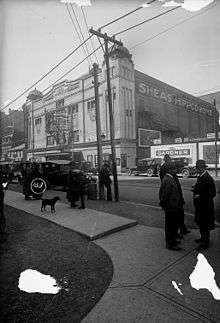Shea's Hippodrome
| the “Hipp” | |
 Taken from Albert street, on the north corner of Old City Hall | |
| Address | Canada |
|---|---|
| Location |
Queen and Bay Toronto, Ontario |
| Coordinates | 43°39′07″N 79°22′57″W / 43.65184°N 79.38241°WCoordinates: 43°39′07″N 79°22′57″W / 43.65184°N 79.38241°W |
| Owner | Jerry and Michael Shea |
| Operator | Famous Players |
| Capacity | 3,200 [1] |
| Construction | |
| Opened | April 27, 1914 |
| Closed | December 27, 1957 |
| Construction cost | $245,000 |
| Architect | L H. Lempert |
Shea's Hippodrome was a historic film and play theatre in Toronto, Ontario, Canada. The Hippodrome was located in downtown Toronto, at the corner of Queen and Bay, (now Nathan Phillips Square). At its opening in 1914, it was the largest movie palace in Canada, and one of the largest vaudeville theatres in the world.[2] The Hippodrome included 12 opera boxes, a Wurlitzer organ, as well as a full-size orchestra pit. It debuted some of Canada's first non-silent films. It was built by brothers Jerry and Michael Shea and situated directly across from Toronto's Old City Hall. The Hippodrome was operated by Famous Players and managed for decades by Ken Bishop. It was demolished in 1957 to make way for Toronto's new City Hall.[3]
Venue
Prior to Shea’s Hippodrome, the Shea brothers first took over and operated the former Robinson's Musee Theatre (also known as the "Bijou") as Shea’s Yonge Street (also known as the "Strand") in 1899. The brothers then built the Shea’s Victoria nearby.[2]
The theatre was constructed in renaissance style, with arched (and 'electrified') ceilings. The theatre featured an allegorical painting by George Brant, and uniquely included a coin-operated candy dispenser.[4] A hippodrome historically is a large circular ancient Greek theatre. Though Shea's was not round, the word was sometimes adopted for large theatres at the time.[5]
Before installing a Wurlitzer organ in 1926,[5] Shea's included an Orchestron machine, a punch-tape programmed precursor to a modern synthesizer. House organists included Kathleen Stokes, Colin Corbett, Quentin Maclean and Al Bollington.[6]
Vaudeville
'The Hipp' was on the Family Time, and later the Super Time vaudeville circuits. It hosted many of the world's greatest vaudeville acts including:[3][6]
Talkies
In 1924, Shea's debuted its first 'talkie' - a non-silent film, called a 'phonofilm'. The first talkie was called 'The Studio Murder Mystery'. Originally thought to be a novelty, talkies later became the main source of income for supporting the declining vaudeville revenue.[4]
Over years, Shea’s screened films such as the Ten Commandments (1956 film) and many of Elvis Presley's movies. In 1941, the Abbott and Costello film Buck Privates played for a record 14 weeks.[5]
Closing
Shea's Toronto was one of the last remaining vaudeville theatres in North America to remain open during Word War II. The theatre closed just after Christmas in 1957. The last film to play at Shea's was Elvis Presley's Loving You (1957 film). The Wurlitzer organ was sold to Maple Leaf Gardens (and later sold to Casa Loma).[5] Though closed, the building was not demolished for some time, and Toronto's replacement 'civic center' was not completed until 1965.[4]
Further reading
- Palaces of the Night, Canada’s Grand Theatres - by John Lindsay
- The development and nature of vaudeville in Toronto: from 1899 to 1915 - by Gerald Lenton